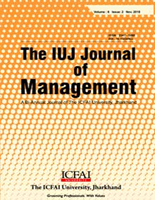( Thirupathi Chellapalli & D.V. Srinivas Kumar )
Keywords : electronic recruitment, online recruitment awareness, e-recruitment adoption, e-recruitment portals, demographics.



 The IUJ Journal of Management (IUJ-JOM) is the flagship journal of ICFAI University Jharkhand, Ranchi. The aim of the journal is to provide insight into the business and management research. It also creates a platform for the researchers, academicians, professors , practicing management professionals and proponents in disseminating original, theoretical and applied research in the field of management and allied disciplines.
The IUJ Journal of Management (IUJ-JOM) is the flagship journal of ICFAI University Jharkhand, Ranchi. The aim of the journal is to provide insight into the business and management research. It also creates a platform for the researchers, academicians, professors , practicing management professionals and proponents in disseminating original, theoretical and applied research in the field of management and allied disciplines.
The Journal is a Bi-Annual (November and May), double blind reviewed journal, . . . . .Read more.
 As global competition persists and industries becoming
more skill intensive, the recruitment of talent workers
becomes essential, and attracting the right applicants at
the right time is getting tougher than ever. The use of
conventional recruitment methods no longer suffices and
timely to attract a sufficient pool of qualified applicants.
As global competition persists and industries becoming
more skill intensive, the recruitment of talent workers
becomes essential, and attracting the right applicants at
the right time is getting tougher than ever. The use of
conventional recruitment methods no longer suffices and
timely to attract a sufficient pool of qualified applicants.
Many organizations have turned to adopting
sophisticated recruitment strategies or combining various
recruitment methods to attract them. . . . . . .Read more.
 According to Confederation of Indian Industries (CII),'Corporate Governance occupies mind space of the government,
regulators, corporate, boards, markets, employees and investors
- almost the entire society - as one of the most important business
constituents given its all-pervasive characteristic'. The
corporate governance mechanism is much more crucial in
the banking sector due to multifold reasons.
According to Confederation of Indian Industries (CII),'Corporate Governance occupies mind space of the government,
regulators, corporate, boards, markets, employees and investors
- almost the entire society - as one of the most important business
constituents given its all-pervasive characteristic'. The
corporate governance mechanism is much more crucial in
the banking sector due to multifold reasons.
Banks serve a crucial link in the nation's financial system, banks are
highly leveraged as they accept large amount of
uncollateralized
. . . . .Read more.
 The payment industry has undergone a drastic shift from
barter system to E- wallets. Customers globally are not
very comfortable with transferring money through the
internet, especially the older generations. Digital wallets
give them the sense of security by acting as a wall between
the bank and the vendor. Since digital wallets have a limit
to the cash that they can hold, any loss—in the event of a
security breach—is limited.
The payment industry has undergone a drastic shift from
barter system to E- wallets. Customers globally are not
very comfortable with transferring money through the
internet, especially the older generations. Digital wallets
give them the sense of security by acting as a wall between
the bank and the vendor. Since digital wallets have a limit
to the cash that they can hold, any loss—in the event of a
security breach—is limited.
Further, for all the
stakeholders a wallet leaves a money trail that helps in
solving disputes. . . . . . . .Read more.
Subscribe now to get notified about IU Jharkhand journal updates!
( Thirupathi Chellapalli & D.V. Srinivas Kumar )
Keywords : electronic recruitment, online recruitment awareness, e-recruitment adoption, e-recruitment portals, demographics.
( Pema Lama & Sujoy Kumar Dhar )
Keywords : Governance, Non-Performing Asset, Bank, Capital Adequacy Ratio.
( Dr. Mamta Brahmbhatt )
Keywords : Factors, Buying Behavior, Customer, Software Product, Software Market.
( Nancy Kumari & Dr. Pallavi Kumari )
Keywords : Employee Turnover, Retention Strategies, Attrition, Retaining Employees etc.
( S.M.Vipul & Dr. Nitesh Bhatia )
Keywords : Digitization, Online Payments, Secure transactions, Property/House Tax
( Dr. Sukanta Chandra Swain & Dr. Susan Das )
Keywords : Good Governance, Globalization, Democratic Societies, Cross-Cultural
( Visweswar Kandikonda )
Keywords : Risk Management, industry, potential risks, Enterprise Risk Management
( Praveen Kumar & Dr. Mridanish Jha )
Keywords : Employee engagement, challenges in employee engagement, implementation of employee engagement, Service model.
( Dr. Sweta Singh & Dr. Manish Kumar )
Keywords : Work life balance, management teachers, employee, stress, stress management
( Dr. Soumitro Chakravarty , Dr. Umesh Prasad & Dr. AmarNath Jha )
Keywords : Corporate Citizenship; Corporate Social Responsibility; Government; State; Corporations;
(Prof. Rohin Bhatanagar , Dr. Rumna Bhattacharya & Dr. Ratna Sinha )
Keywords : E-commerce, E-Tailing, Cyber Security, online portals.
( Ajit Kumar & Prof. J.K.Choudhary )
Keywords : GST, Indirect Tax, Coal Mines
( S.M.Vipul , Pooja Shukla & Dr. Rakesh Kumar )
Keywords : globalization, entrepreneurs, resources, sustainability, technology.
( Jyoti )
Keywords : Leadership qualities, rural women entrepreneurship, corporate women.
( Dr. Mohit Kumar )
Keywords : Liberalization, Independence, Vibrant, Infrastructure, Marketing, Juncture, Investments.
( Dr. S. K. Padhi )
Keywords : Retail Management, Service Management, Service Quality.
( Harsha Bhargavi Pandiri )
Keywords : Social media, 1% rule of thumb, Users and gratification, social interaction, print media and electronic media.
( Pradeep Kumar Hazari )
Keywords : Dairy, feed industry
